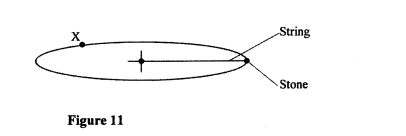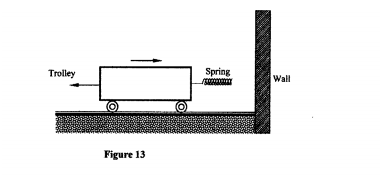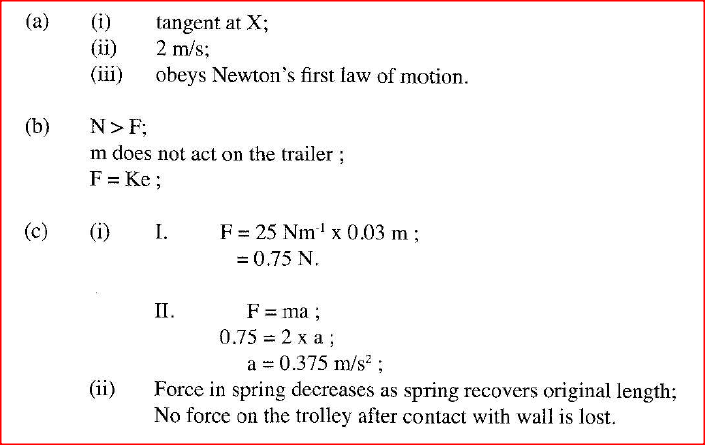K.C.S.E Physics Q & A - MODEL 2011PP1QN16
Figure 11 shows a stone attached to the end of a string moving in a horizontal circle with a uniform speed of 2m/s. When the stone reaches point X on the circle, the string breaks.
(i) indicate on the diagram with an arrow, the direction of the motion of the stone when the string breaks.
(ii) State the magnitude of the velocity after the string breaks. (iii) Give a reason for your answers in (i) and (ii). (b) Figure 12 shows a lorry towing a trailer using a rope.
The lorry exerts a force N on the trailer and the trailer exerts an equal but opposite force M on the lorry. The frictional force between the trailer and the road is F.
Explain how the forces N, M and F enable the trailer to move. (c) Figure 13 shows a frictionless trolley of mass 2kg moving with uniform velocity towards a wall. At the front of the trolley is a spring whose spring constant is 25N/m. The trolley comes to rest momentarily after compressing the spring by 3cm and then rebounds from the wall.
(I) Determine
(I) the force exerted on the wall by the spring. (II) the maximum acceleration of the trolley as it rebounds from the wall. (ii) State the reason why the trolley acquires a constant velocity after it rebounds.
0 Comments
Leave a Reply. |
CATEGORIES
Categories
All
Topics
FORM I - PHYSICS SYLLABUSFORM II - PHYSICS SYLLABUSTOPICS
FORM III - PHYSICS SYLLABUSFORM IV - PHYSICS SYLLABUSARCHIVES
RSS FEEDS
AUTHOR
M.A NyamotiMy passion is to see students pass using right methods and locally available resources. My emphasis is STEM courses
|
We Would Love to Have You Visit Soon! |
Hours24 HR Service
|
Telephone0728 450425
|
|
8-4-4 materialsLevels
Subjects
|
cbc materialsE.C.D.E
Lower Primary
Upper Primary
Lower Secondary
Upper Secondary
|
teacher support
Other Blogs
|




 RSS Feed
RSS Feed